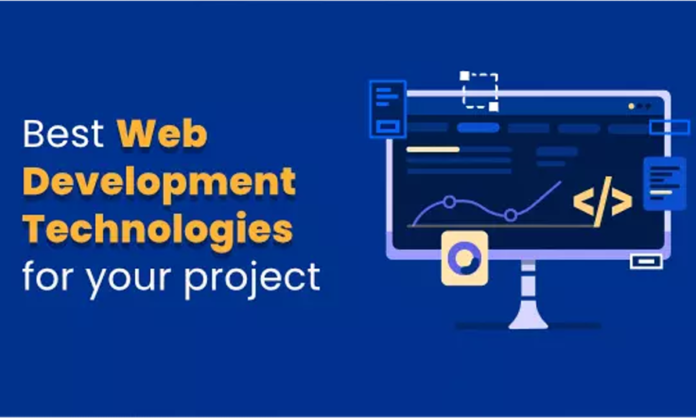
Basically, web development technologies comprise the core of what makes up the internet. It ranges from programs and frameworks to programming languages that make it possible to make websites responsive and dynamic interactively for developers. Since more business brands and people put their identities online, the relevance of knowledge about technology also increasingly falls into the same domain.
Most important reasons why web development technologies are important
In a nutshell, websites are not just ornaments, but they need to be functional, secure, scalable, and efficient. It may be simple blogging or could even be something as complex an e-commerce platform; frontend, backend, and database technologies need to be applied correctly.
Top Frontend Web Technologies
Front-end technologies are totally dependent on the client-side of the website, therefore that part which people see and access through. This side gives chance to the developers so as to work upon the creation of interacting, fast, and aesthetic web pages.
1. React
This frontend library is developed by Facebook. Today, one of the most widely used frontend libraries in the present days is this library itself. Among its basic features is one-way data binding which has provided many performance benefits with low complexities. The technology is well-suited for dynamic alteration without re-loading the web page.
Key Features: Virtual DOM, Reusable components, Community support
Usage: SPAs, Dynamic web application.
2. Vue.js
Vue.js is an open-source framework, it is pretty free and lightweight. Besides two-way data binding, it has a clean, nice, and intuitive API that presents a great interest in the application for young developers alike pros.
Main benefits: watchers of change within data, follows a component-based architecture, integrates very well.
Used in the following applications: User interfaces, progressive web applications .
3. Ember.js
Ember.js is very productive and focusing on the build pipeline. It is very good for complex web applications and saving a pretty rich set of features by default, that easily update at high performance.
Key Benefits: It has powerful build pipeline, backward compatible, and highly documented.
Use Cases: complex web applications like online shopping portals
4. Backbone.js
In short words, Backbone.js is a framework that accepts the structure of the web application with key-value binding and custom events on the models. Extremely light framework; really useful if one needs something more than plain JavaScript but actually does not need a whole framework.
Key Benefits: Flexibility, easy to use and module
Use Cases: for low-requirement single-page applications.
5. Angular
Angular is a package of Google well-rounded excellent for large-scale projects. Two-way data binding capability and dependency injection mean developers need productivity to create small complex applications.
Key Strengths: Consistency, awesome community support, and good performance.
Use Cases: Large-scale enterprise applications and SPAs on more complex scenarios.
Top Backend Web Technologies
All this technologies give the chance to ensure everything works great in the back end of an application, from the sending and processing of requests up to work with databases and providing smooth interaction with the presentation in front end.
1. Ruby on Rails
Ruby on Rails is very opinionated. Really a darling for web developers because it can prototype quickly and offer some brilliant features such as Turbolinks or Active Record, which minimize boilerplate code.
Development Speed: Defined by many configurations and built-in testing tools
Use Cases: Start-ups, content-based websites, e-commerce platforms
2. Express.js
Actually it is a minimalist approach since Express.js is an unopinionated Node.js web framework. With these minimal backend frameworks – Express.js, fast web apps and APIs are possible
Main Advantages: applications are very lightweight and quite easy to configure in real time
Use Cases: REST APIs, SPAs, Applications with real-time chat
3. Django
Django: Absolutely, one of the safest but the most effective high-level Python frameworks that scale up very quickly, though it builds up very quickly due to features like authentication and the admin panel.
Key Features: ORMs/scalability with good documentations
Usage: CMS/enterprise applications/social media apps
4. Node.js
Node.js is not a framework; it’s a more environment-at-run time. It allows running one’s JavaScript on the server-side. It is non-blocking; therefore, high efficiency in cases of asynchronous requests.
Important Benefits: Extremely fast, event-driven architecture, and scalability.
Use Cases: Streaming applications, real-time applications-for example, application that will be used to have a chat or some gaming.
5. Flask
Flask: Light-weighted Python web framework, indicating the bare basics of a web application. It is flexible and can integrate any third-party library with the feature that a developer requires .
Key Benefits: Simple, light-weighted and modular design.
Use Cases: Microservices, small to medium-sized web applications.
Top Database Web Technologies
A good database helps efficiently in storing, retrieving, and managing the data. The most commonly used database technologies while developing a web application are as follows
1. Oracle
Oracle owns the richest database technologies for high availability applications with huge amounts of data in hand. They are scaled and performance-tuned through proper engineering capabilities, thus performing very well even for big enterprises.
Key benefits: feature of high availability, high performance, and advanced security features.
Use cases: Big e-commerce systems and ERP
2. MongoDB
MongoDB is a NoSQL DBMS, but with known strengths when handling large amounts of unstructured data. The scheme is document-oriented; thus, it meets data distribution goals by way of storage and retrieval.
Major Benefits: Scalability, flexibility and quick access
Use cases: Big Data applications, Content Management Systems, Real-time analytics
3. MySQL
Of all, the most popular relational database is MySQL. This database is famous for its usability and flexibility. Such applications use MySQL if they need to have both ACID compliance and complex handling of queries.
Key Benefits: Open source, high flexibility and supports big data.
Use Cases: E-commerce website, content management systems.
4. Cassandra
Cassandra is designed to handle large amounts of distributed data distributed across many nodes. Availability with no single point failure It will be suitable for all applications those should be scalable as well as highly available.
Key Benefits: Distributed Architecture, Fault Tolerant, Real time data processing
Use Cases: IoT Application, Social Media Application, Big Data Application
5. IBM Db2
IBM Db2 does have massive scalability in hosting large volumes of data, and also carries AI-based analytics capabilities. They are generally meant for enterprise applications, and they come with great SQL support.
Key strengths: Great high-level AI integration, massive transaction capacities, and security forms part of the system.
Usability applications: Bank systems, big applications like any enterprise-wide application, and analytic-based data applications.
Conclusion
Every web development project is unique. For instance, it’s dominated at the front end by React and Vue.js and behind the backend by niches created by Ruby on Rails and Node.js. MongoDB and MySQL databases keep hosting millions of applications all around the world.
It’s an evolving web development ecosystem; newer tools and technologies are released frequently. By proportion, this demand for fast, efficient, and scalable solutions on the web is equal. So, any developer or business owner who wants to build something on the web that’s going to be a “big thing” must be very well-versed with these trends and technology.












